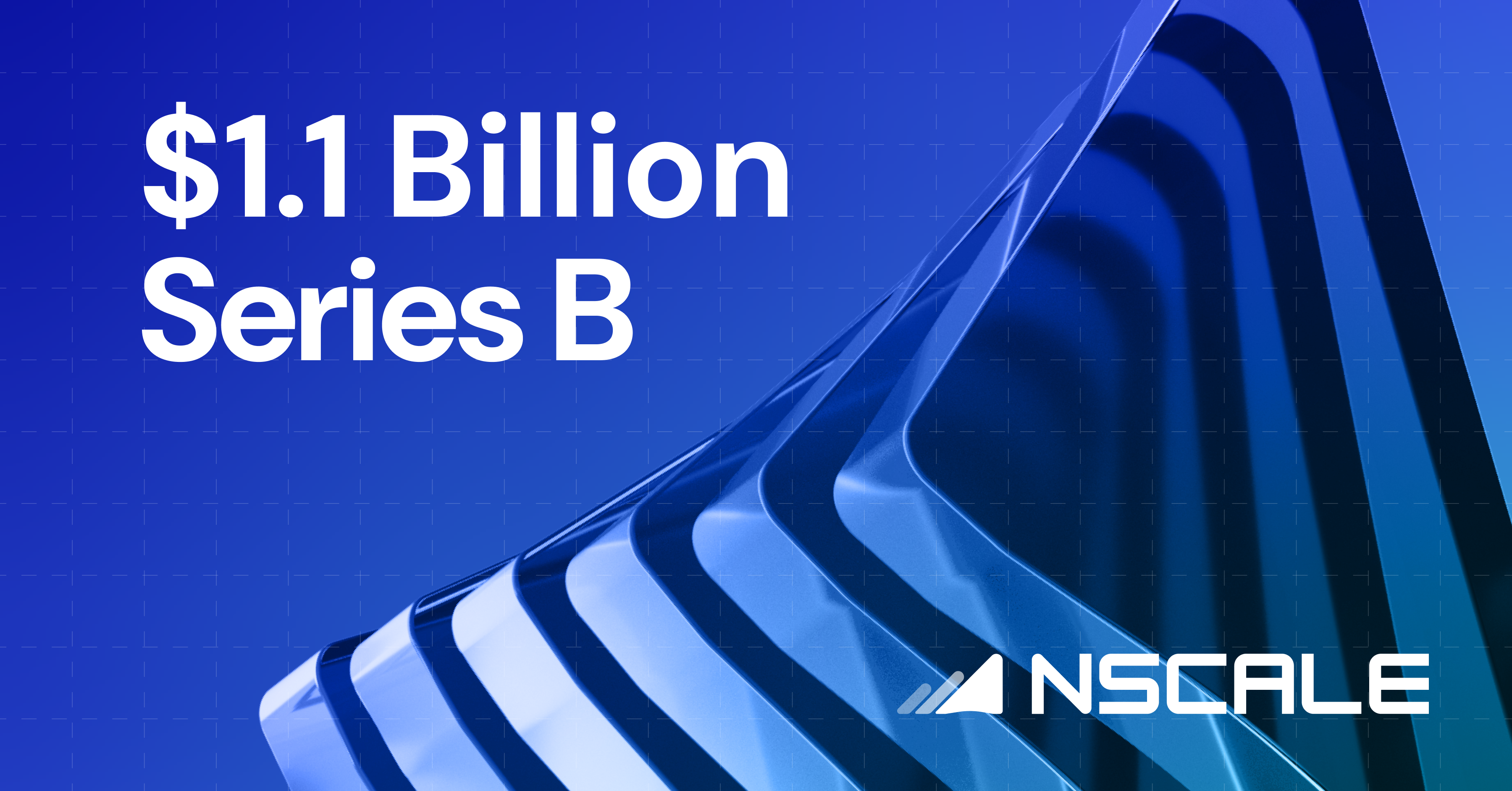
AI Infrastructure Startup Nscale Raises Record-Breaking $1.1 Billion Series B to Build European GPU Data Centers
European AI Firm Nscale Raises Record $1.1 Billion to Take On U.S. Rivals
LONDON — Europe just fired a major shot in the global AI infrastructure race. London-based startup Nscale has secured a record-breaking $1.1 billion in Series B funding, the largest of its kind in Europe. The raise, led by Norwegian industrial powerhouse Aker ASA, values the company at about $3 billion and sets the stage for a bold challenge to U.S. dominance in the GPU cloud market.
The deal arrives at a crucial moment. Governments and businesses across Europe are scrambling to secure access to the computing power needed for artificial intelligence. Rising concerns over data sovereignty and soaring energy costs have pushed the conversation beyond efficiency—it’s now about national security and competitiveness.
Nscale’s pitch is simple but powerful: tap into cheap Nordic hydroelectric energy and cold Arctic air to run massive GPU clusters at lower cost while keeping data inside European borders.

Chasing Cheap Power in the North
What gives Nscale its edge? Northern Norway’s electricity sells at a fraction of what cities like London or Berlin pay. Pair that with naturally cool Arctic weather, and you get the perfect conditions to run energy-hungry GPU farms without massive cooling bills.
The company is betting big on two projects. In Norway, its Stargate Norway venture—built alongside Aker ASA and OpenAI—plans to roll out 100,000 NVIDIA GPUs by the end of 2026. Tech giant Microsoft has already signed a $6.2 billion, five-year deal to use the facility in Narvik.
Meanwhile, across the North Sea, Stargate UK will rise at Nscale’s Loughton campus with backing from Microsoft, NVIDIA, and OpenAI. That site is on track to become Britain’s largest AI supercomputer. By early 2027, it’s expected to house more than 23,000 NVIDIA GB300 GPUs, worth nearly $1.4 billion in hardware before adding networking and storage.
Who’s Backing Nscale
The investor list reads like a lineup of industry heavyweights. NVIDIA not only chipped in up to $500 million but also promised to supply as many as 300,000 chips over time. Nokia joined as both investor and networking partner, while Dell strengthened the supply chain on the server side. Institutional giants such as Fidelity and Point72 added credibility and deep-pocketed support.
This strategy isn’t new. It mirrors the vendor-customer loops in the U.S., where chipmakers and cloud providers invest in each other to lock in supply and demand.
Big Plans, Bigger Risks
The path ahead isn’t smooth. For all its ambition, Nscale has yet to prove it can build and run a full-scale data center on its own. Running cutting-edge liquid cooling and high-speed networking at scale isn’t easy, and delays could prove costly.
There’s also the challenge of hooking into Norway’s power grid. While the country has plenty of renewable energy, connecting massive facilities to the grid means navigating political approvals and utility planning cycles that often move at a snail’s pace.
Analysts warn of another risk: circular financing. When hardware vendors bankroll their own customers, valuations can swell beyond reality. If AI demand doesn’t meet expectations, companies like Nscale could find themselves exposed.
Politics, Policy, and “Sovereign Compute”
European leaders have made no secret of their push for technological independence. The UK’s AI minister, Kanishka Narayan, openly endorsed Nscale’s role in strengthening national competitiveness. The EU, too, is crafting rules aimed at securing control over critical technologies.
This focus on “sovereign compute” could work in Nscale’s favor, especially with industries and governments that insist on local data handling. Still, policy winds shift quickly. If regulations change, so might the economics of building such massive facilities.
Pricing Pressure on the Horizon
Right now, GPUs are gold. Cloud providers charge up to $12 per GPU-hour for the most advanced chips, while smaller operators ask around $3 to $4. Those sky-high prices have attracted competitors like CoreWeave, Crusoe Energy, and Nebius, all of which are eyeing Europe.
But markets don’t stay hot forever. Analysts expect GPU-hour pricing in Europe to fall 10–20% by 2027 as new capacity comes online. That gives Nscale a tight window to fill its clusters and lock in customers before margins shrink.
The company’s projections count on $8 per GPU-hour at 65% utilization, numbers that would translate into more than $5.5 billion in annual revenue across its UK and Norwegian sites at full scale. Those figures look impressive, but only if everything goes according to plan.
Why Investors Care
For investors, Nscale offers a play on three powerful themes: cheap Nordic power, Europe’s push for sovereignty, and the explosive demand for AI computing. If it pulls off its expansion, Nscale could become Europe’s answer to America’s GPU cloud giants.
Still, the timeline is unforgiving. Lighting up the first 150 megawatts in Narvik by mid-2026 will make or break the company’s credibility. Fail, and doubts will grow fast. Succeed, and Nscale may secure a lasting place in the global AI infrastructure race.
In the end, the $1.1 billion raise shows one thing clearly: Europe isn’t content to sit on the sidelines of the AI revolution. With cheap power, political backing, and deep-pocketed partners, Nscale is betting it can shift the balance of power—literally and figuratively—in one of the world’s most competitive industries.
House Investment Thesis
| Aspect | Summary |
|---|---|
| Deal Overview | $1.1B Series B for Nscale, a European GPU-as-a-service provider. Post-money valuation ~$3B. A high-execution, high-refinancing risk buildout. |
| Core Thesis / "Momentum Trade" | A "sovereign GPU" play leveraging Europe's demand for jurisdiction-bound capacity, underpinned by credible power economics (cheap Norwegian hydro), marquee offtake (Microsoft), and strategic vendor lock-ins (Nvidia, Dell, Nokia). |
| Key Drivers / "Why Now" | 1. GPU Scarcity & Sovereignty: Constrained GB200/GB300 supply; EU/UK demand for local capacity. 2. Power Arbitrage: Structurally low Northern Norway power prices (~NOK 0.05/kWh) vs. core EU metros. 3. Strategic Money Loops: Nvidia invests ($500M, 300k chips) and commits supply; OEMs/hyperscalers create a circular financing pattern. |
| Key Assets & Commitments | - UK (Loughton): Target 23,040 GB300 GPUs, scaling from 50MW to 90MW by Q1 2027. - Norway (Narvik): Staged deployments from 2026 under a $6.2B Microsoft offtake agreement via a 50/50 JV with Aker. |
| Bubble Checklist / Risks | - Circularity Risk: Vendor equity + supply + offtake concentrates risk; props valuations until a break. - Execution Overrun: Capacity race outruns grid/permits and talent; slips past 2026 are likely. - Tech Deflation: Open-weight AI models lower training costs, compressing future GPU-hour rents. |
| Financial Model (Base Case) | - UK Revenue (23k GPUs @ $8/hr, 65% util): ~$1.05B/yr. - Norway Revenue (100k GPUs by end-'26 @ same rate): ~$4.56B/yr (gross, pre-JV splits). - Valuation Context: $3B post-money requires line-of-sight to $300-600M run-rate for a 5-10x sales multiple. |
| Critical Execution Risks | 1. Supply Chain Slips: GB200/300 transitions and OEM rack deliveries are pacing items. 2. Grid/Political Risk: Norway may tighten data center oversight and power allocation. 3. Price Compression: Increased European supply from competitors will compress GPU-hour pricing. 4. JV Complexity: Cash flow recognition and equity value creation depend on JV accounting terms. 5. Operational Maturity: Unproven track record at scale for owned data centers, especially liquid cooling and networking. |
| Strengths / Bull Case | - Durable Power Edge: Norwegian hydro and climate are hard-to-copy advantages. - Sovereign Tailwinds: Policy support for compliant, local compute with key partners (MSFT, NVDA). - Networking Moat: Partnership with Nokia for inter-data center optical/IP stack is a sleeper asset. |
| Scenarios (12-24 Month Probabilities) | - Base (50%): Staged rollout, UK slips a quarter; $600-900M run-rate by end-2026. - Bear (30%): Supply slips, price compression; run-rate <$400M; requires refinancing. - Bull (20%): Flawless execution, 100k+ GPUs landed; run-rate >$1.5B with improving economics. |
| Key Diligence Items | 1. Contracts: Scrutinize Microsoft offtake terms (pricing floors, penalties, JV revenue recognition). 2. Procurement: Confirm binding Nvidia GPU allocations and delivery windows. 3. Infrastructure: Validate interconnect design and liquid cooling commissioning schedule. 4. Power: Verify grid connection timelines, PPA terms, and price hedges. 5. Unit Economics: Model $/GPU-hour against competitors, assuming 15-25% price drift by 2027. |
| Final Bottom Line | Not a tourist round due to real advantages and backing. However, the $3B valuation prices in 2-3 years of flawless execution in a market showing signs of circular financing and future price compression. Underwrite selectively, tying capital to hardware delivery milestones and modeling conservative pricing/JV cash flows. |
NOT INVESTMENT ADVICE